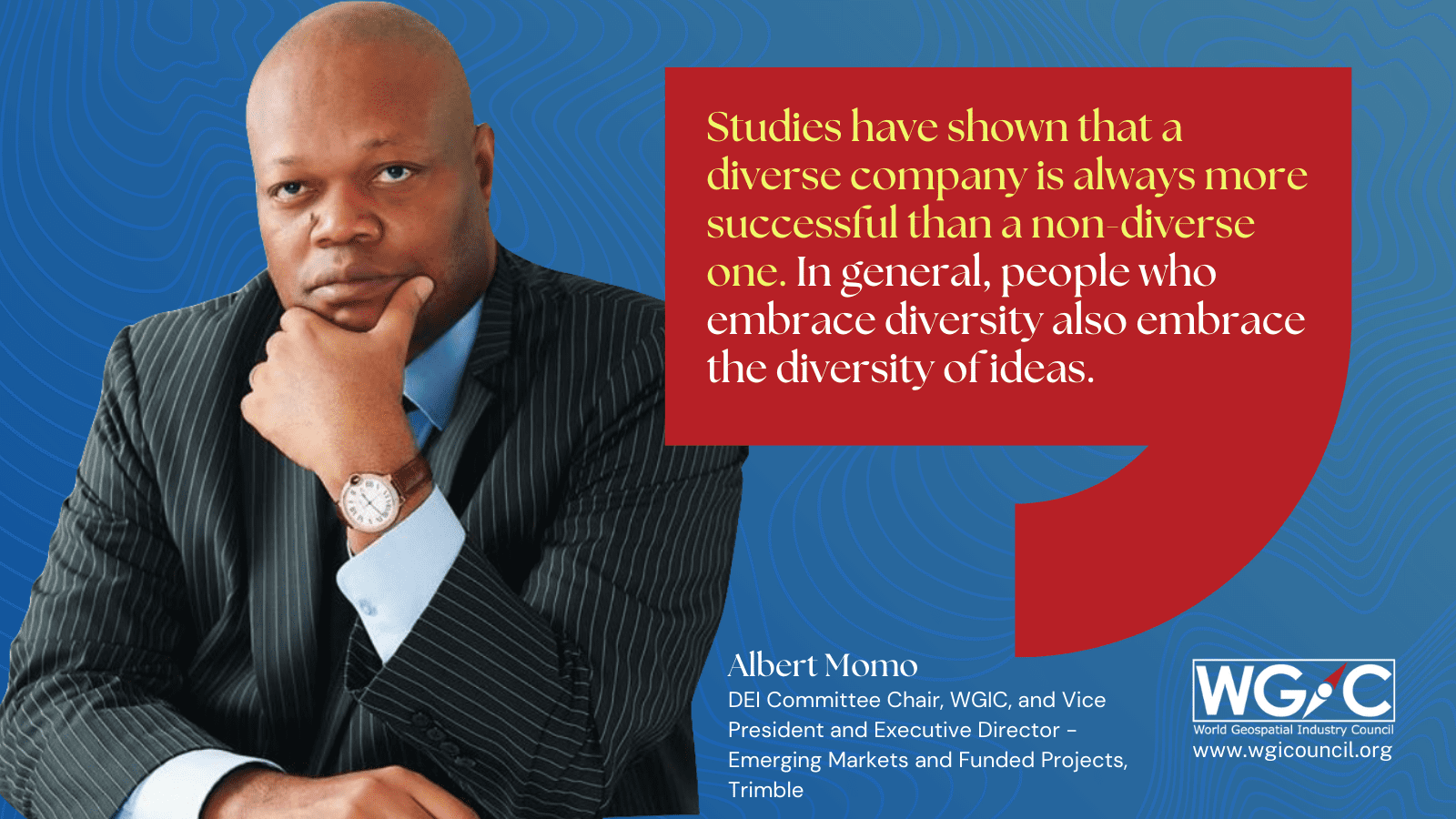Sprague: Albert, thank you for joining us today. You have an impressive background both as Trimble and WGIC. Tell us a little bit more about your background and the work you do.
Momo: I’m leading a team called Emerging Markets and Funded Projects at Trimble. The objective of my team is to look for opportunities for Trimble in the emerging market. What we call emerging markets are countries in Latin America, Africa, parts of Europe, and a large part of Asia. To manage that, we have business development managers in those regions. Also, we have people providing support in tender preparation and project management execution. So, we are the part of Trimble that reaches the developing world, looking for opportunities for the entire company.
Ruggeri:I am always happy for the opportunity to share thoughts with you and ask questions. Could you please tell us a little about your work with the WGIC? What are some of your top goals as a DEI Committee Chair?
Momo: WGIC is an organization of almost 40 companies in the geospatial arena. That organization is basically the voice of all the geospatial companies. We have many large geospatial companies as our members, like Trimble, Esri, or Hexagon but also many small companies from South Africa or other parts of the world. My role as the chair of the DEI Committee, as well as the role of other committee members, is to push the DEI agenda. We noticed the lack of diversity in the geospatial arena, and we asked ourselves, as a leading industry organization, what we could do about it.
Since almost every WGIC member organization individually has a DEI program and/or policy, we tried to understand what it is that we all share and, therefore, as an organization, that groups geospatial companies, what can be pushed. We started by putting together a white paper on DEI in the geospatial sector. As you can imagine, such a white paper is very simple; we lack diversity, whether it is diversity based on race, gender, economic situation, or other elements. The second topic is whether it is really important to have DEI. The answer that the white paper gave is yes. There are so many reasons why DEI should be a concern for everyone in general and, in our case, in the geospatial and construction industries.
Ruggeri:That’s great to hear, Albert. I hope we can get additional information on this white paper to understand why diversity, equity, and inclusion are so important. What were the reasons that served as a catalyst for you to form this committee, and how did you communicate that through the white paper?
Momo: In the wake of what happened in 2020, for the first time, I may say, in the corporate world, the topic of diversity was raised to a level where almost every company had to take a stance on diversity and DEI and racial discrimination.
I participated in many geospatial events, and you don’t have to be a genius to notice the lack of diversity. I mentioned the diversity of race, gender, and national origin, but it is also about the diversity representing the economic situation of people, companies, or countries. There are so many places where we feel like something is missing.
I am glad that when we started the conversation within WGIC, I may say unanimously, everybody agreed about the lack of diversity, equity, and inclusion. I believe the acknowledgment of the issue is already half of the solution. Now, we can sit down and say what exactly the problem is (what the white paper tried to accomplish) and what the solutions are. The first step for us was a policy paper that we want all the geospatial companies that are members of WGIC to agree on and follow. We wanted to make clear that a geospatial company, for example, shouldn’t discriminate people based on race, gender, sexual orientation, religion, or national origin.
Of course, it was easy for people to adopt that.
The second step was agreeing on the wording between ‘equality’ and ‘equity.’ Because we are a global organization, we spend a lot of time ensuring that we agree on words. As you know, most of our counterparts in Europe use the word ‘equality.’ In the United States, we use the word ‘equity,’ and I think we have good reasons to use that word. As a human being, I don’t want to fight to tell someone that I’m their equal. It isn’t even a way to start the conversation. You have to assume that you are equal. Equity means something else. I’m so pleased that, in the end, we convinced people that the best word to represent what we are looking for and what we want to accomplish is ‘equity.’
We want to make sure that we are a very inclusive organization. Being inclusive is more than just people. It’s also about organizations. After all, WGIC represents a group of companies. We want to ensure that we have a company like Trimble and maybe a small company from Kenya on the same table. We want to make sure that within the organization, the idea of inclusion is something that everyone embraces.
Ruggeri:We love talking about advancing smart cities and artificial intelligence (AI), and the internet of things (IoT) in the construction industry. However, we often leave it out of the conversation when it comes to the point of providing everyone with equal access to resources and opportunities. Do you have comments on this?
Momo: I understand what you say, Lisa. At my day job, I work with those geographies of the world where some innovative technologies are part of what we consume now. I also communicate with parts of the world where AI is still a foreign concept. For some countries, a smart city may be a goal for 10-15 years from now or maybe something that is not even pronounced during the municipal council meeting.
Whenever I address some of our customers or potential customers, the conversations often touch on the topic of the fourth industrial revolution. However, most countries miss the first three industrial revolutions. The best thing about the fourth one is that you don’t have to go through the previous three. We have examples of that. Look at the cellphone revolution. Many countries went from not having a very wealthy infrastructure or a good network of landlines to not only having better coverage but also a lot of people in the country having cellphones, including all the services that come with them (e.g., fintech services).
The question is, how can we use technology to advance DEI ideas? How can we see technology as a way to erase some past issues? That’s where the concept of smart cities may be interesting. For example, Cape Town in South Africa is considered a leader in the smart city theory, but the city was also part of Apartheid where all the discrimination happened. The good thing about the concept of a smart city in Cape Town is that they are making a digital transformation of the city regardless of who you are. Thus, they are giving access to smart services to all the citizens without any discrimination. This way, they make sure that schools, for example, prepare students to embrace the type of world they will be living in. They are also ensuring that all the services the city offers are smart enough regardless of race and economic situation. Thus, yes, Lisa, smart cities can actually be a vehicle for DEI.
Sprague: Albert, I’m going to try to double-click down on the construction industry again. Why is thinking about diversity and inclusion important in the geospatial and construction sectors? How can it affect an organization’s performance, as an example, or how can it affect the structures of cities and communities that support the citizens’ daily lives?
Momo: Studies have shown that a diverse company is always more successful than a non-diverse one. In general, people who embrace diversity (e.g., race, religion, nationality) also embrace the diversity of ideas. You have to be open-minded to accept that someone who doesn’t look like you has something to say and is a valuable asset to your company. Once you already have that mindset, you will also value the diversity of ideas.
If you go a step further, you will also try to understand different communities that have their own history, elements, and factors. Thus, you will show that you are willing to understand what those communities have, to later offer them the best service. So yes, on a more economical aspect, DEI in geospatial and in construction should lead to more revenue. More importantly, it will eventually lead you to build a better company.
Ruggeri:Do you think that a city can be anti-racist? What would that look like, an anti-racist city?
Momo: That depends. Probably, I am going to contradict myself trying to answer this question. What element of anti-racism is actually bad? That element is that if you define anti-racism as another racism. If anti-racism is actually about becoming the racist of the racist, it is bad. If you look at anti-racism from the point of how we can evolve from it and have a more integrated universe or theory, in this case, this is actually a good thing. Cape Town is a good example. They are successfully integrating different communities within the city. I see an anti-racist city as a city where you feel you belong regardless of who you are.
Ruggeri:Thank you, Albert, and I could not agree more with what you just shared. Do you have a great story to share about when construction or geospatial technologies have been used to correct social, racial, or economic injustice?
Momo: Maybe, the example of the city where I live – Washington DC. Washington DC, in my mind, is doing a very good job integrating people and making sure that the city’s services are accessible to all inhabitants. People may not know that, but 20 or 25 years ago, DC was one of the most discriminating cities in the United States. Now, because of some of these efforts, it has changed. For example, they use geospatial technology to redefine the way the city will develop by building schools where they’re supposed to be and by putting the resources where they’re supposed to be. They are using our technology to do that, thus making the city more inclusive. DC is now a very diverse, well-integrated city but also a city where many young people choose to start their professional life.
I think the use of geospatial technology to recreate the map of the city, showing how to use its resources better, is something to be mentioned here. DC was way behind using GIS and geospatial technology 20 to 25 years ago, but now the city is way ahead.
Sprague: Finally, Albert, what motto do you live by or find interesting?
Momo: “Do the right thing.” That’s my motto. There are so many things in the word ‘right.’ It is simple and complicated at the same time. Do the right thing for the people, the community, and the company you work for.
Watch the Interview:
EP6 | Building Smart Communities through Diversity, Equity, and Inclusion
More about Trimble’s Connected Construction Show can be found here:connectedconstructionshow.com



